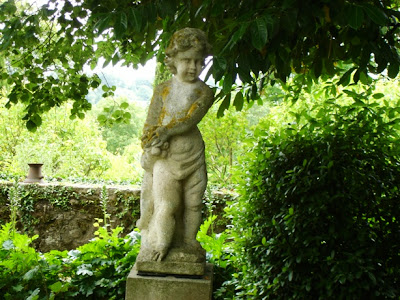Long, long ago, when the world was young – or at least when DH and I were young – we moved with our two small children into an old and decrepit farmhouse high in the hills of Mid-Wales. It came with about half an acre of neglected ground, part would-be garden, part a small, steep, infertile paddock above the house to the north.
In my first flush of enthusiasm at having space to grow things, I started a vegetable plot in the garden behind the house, with some modest success. The following year I decided to try to clear the paddock by planting potatoes there, but the ground is so steep and the soil so poor that this was an experiment I wasn’t tempted to repeat. So the paddock lay fallow for a couple of years, until DH managed to set it alight during the great drought of 1976 and we nearly lost our few trees as well.
Once we had recovered from the shock, we decided something different had to be done with this poor patch of ground, and the sight of our singed trees gave DH a brainwave. He would plant trees! Lots of trees, beautiful specimen conifers (DH loves conifers) which would fill up the paddock and enhance our surroundings. Well, that was the idea….
Unfortunately, when he went to the local tree nursery for his infant conifers, they happened to be having a sale of larch seedlings at a giveaway price. You can guess the rest. Being of Scottish ancestry and therefore not one to sniff at a bargain, DH went mad and bought about fifty of the baby larches, in addition to all the specimen conifers he had already chosen.
Back in those days I worked in a public library, so my first instinct when faced with dozens and dozens of seedling trees was to bring home a book on their planting and care. It was written by a tree specialist, so one might have thought DH would welcome advice from such a reliable source. Not a bit of it! The writer stressed the importance of preparing the ground before planting. DH simply dug lots of small holes. The writer emphasised how essential it was to give trees plenty of room to grow and even provided a useful chart of planting distances, based on eventual height. DH just looked at the seedlings, particularly the tiny larches, and planted them really, really close together, so they would have company.
It should have been a recipe for disaster, and in terms of a formal garden, I suppose it was. The first surprise was just how quickly the seedlings established themselves and grew. Given the poor soil and exposed position of the paddock, we rather expected to lose many, if not most, of them in the first few winters. Gripped by frost, buried in snow, battered by south-westerly gales they might have been, but nothing seemed to deter them. They just grew and grew and grew. Even though they were so closely packed in places that their branches became entangled and they had to strain upwards to the light, still they managed to grow, until today, nearly 35 years later, many of them are towering 40-footers.



Naturally some have succumbed over the years, but they don't go to waste. Indeed, one fine afternoon earlier in the week we were up in the wood, where DH had just sawn up a dead tree, carting the logs down the hill to be split and stored for firewood. As we always find ourselves doing when we’re up there, we kept stopping work to take in the atmosphere of the place: the slanting sunbeams, the sound of the wind high in the treetops mingling with the muted song of birds tuning up for spring.
We stood looking downhill through the trees, down past the house to the wonderful view of the valley and the distant hills, and realised yet again that we have inadvertently created our very own Wild Wood. Tiny, it is true, and not exactly well tended, but with its trees and bushes and brambles a haven for wildlife, a playground for children, and, in its own small way, a magical and mysterious place, where one feels a million miles away from the outside world. It isn’t what we set out to make all those years ago, when DH brought home so many baby trees, but it is living proof that sometimes what happens by accident is better than we could ever have planned.


















































